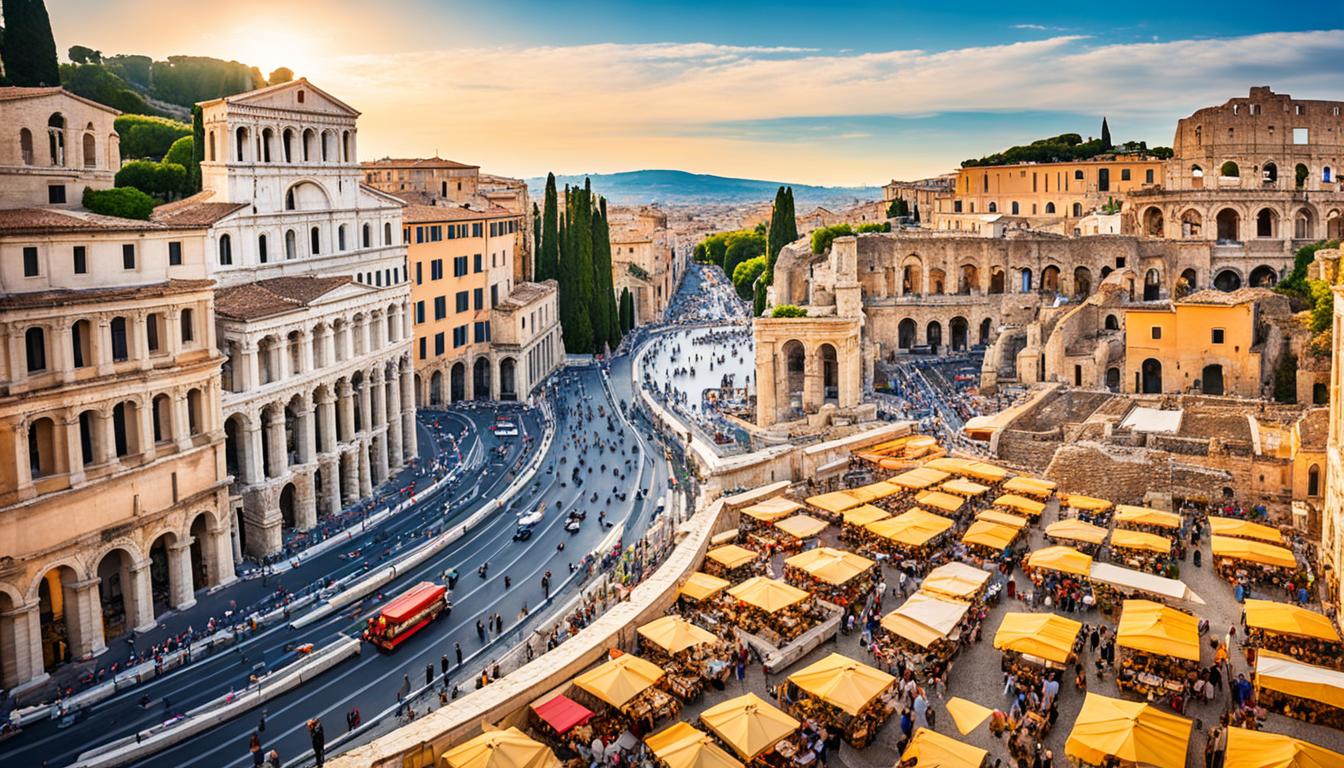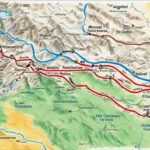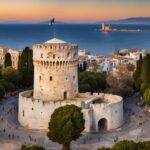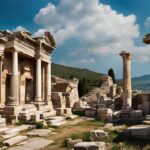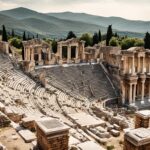Paul’s missionary journeys took him to numerous cities in the ancient world, spreading the Gospel and establishing churches. These cities hold significant historical and cultural importance, making them popular destinations for travelers seeking to explore the footsteps of the Apostle Paul.
Key Takeaways:
- Paul’s missionary journeys spanned various cities in the ancient world.
- These cities are rich in historical and cultural significance.
- Exploring these cities offers insight into the early Christian movement.
- City guides and tours are available to enhance the travel experience.
- Paul’s ministry played a pivotal role in the spread of Christianity.
Paul’s First Missionary Journey
During Paul’s first missionary journey, he embarked from Antioch and visited several cities and regions. This journey laid the foundation for Paul’s future missionary endeavors, as he spread the Gospel message throughout various cities, facing both acceptance and opposition.
Visiting Cyprus
Paul’s first stop was Cyprus, a beautiful island known for its rich history and stunning landscapes. He preached in Salamis and made his way to the coastal city of Paphos. This scenic city, with its ancient ruins and charming harbors, was a witness to the powerful message he proclaimed.
Journey to Pisidian Antioch and Beyond
Continuing his journey, Paul traveled to Pisidian Antioch, where he encountered both receptive audiences and fierce opposition. Despite the challenges, his perseverance and unwavering faith in sharing the Gospel message became evident.
From Pisidian Antioch, Paul ventured further, visiting cities such as Iconium, Lystra, and Derbe. Each city held its own unique cultural and historical significance, providing a backdrop for Paul’s teachings and the establishment of early Christian communities.
This journey not only marked Paul’s courage and dedication but also set the stage for future missionary expeditions that would shape the course of Christianity.
| City | Significance |
|---|---|
| Cyprus | Preaching in Salamis and Paphos |
| Pisidian Antioch | Receptive audiences and opposition |
| Iconium | Establishing Christian communities |
| Lystra | Impact on the local population |
| Derbe | Growth of early Christian churches |
Paul’s first missionary journey laid the groundwork for his future endeavors, demonstrating his dedication to spreading the Gospel and establishing Christian communities in various cities. The impact of his ministry during this journey cannot be overstated, as it set the stage for the growth and spread of Christianity.
Paul’s Second Missionary Journey
On his second missionary journey, Paul embarked on a significant quest to spread the Gospel and strengthen early Christian communities. This journey took him through various cities where he encountered both challenges and triumphs. Let’s explore the key destinations of Paul’s second missionary journey:
Revisiting Lystra and Derbe
Paul began his second journey by revisiting Lystra and Derbe, cities located in modern-day Turkey. It was in Lystra that he encountered Timothy, who later became one of his most trusted companions in ministry.
Establishing a Church in Philippi
Paul traveled to Philippi, a city in Macedonia, where he established a church during his visit. This city holds significance as it was here that Paul encountered Lydia, a prominent businesswoman who became one of the first converts to Christianity in Europe.
Spreading the Gospel in Thessalonica
From Philippi, Paul journeyed to Thessalonica, a thriving cosmopolitan city. Despite facing opposition, Paul dedicated his efforts to proclaiming the Gospel and nurturing the growing Christian community.
Engaging with Intellectualism in Athens
Continuing his journey, Paul arrived in Athens, a center of intellectual and philosophical pursuits. In this vibrant city, known for its academic institutions and philosophical debates, Paul engaged with the prominent thinkers of his time, presenting the Gospel in a context that spoke to their philosophies.
Planting Seeds of Faith in Corinth
The final destination of Paul’s second missionary journey was Corinth, a bustling commercial hub with a diverse population. Here, Paul encountered various challenges and faced opposition, but he persevered in his mission to establish a strong Christian presence in the city.
Paul’s second missionary journey was a transformative experience marked by encounters with believers, engagement with diverse cultures, and steadfast proclamation of the Gospel. His efforts in these cities played a significant role in the development and growth of early Christian communities, shaping the course of Christianity.
Paul’s Third Missionary Journey
Paul embarked on his third missionary journey to further spread the teachings of Christianity and establish a stronger Christian presence in key cities. During this journey, he visited significant locations such as Ephesus, Miletus, Corinth, and Jerusalem.
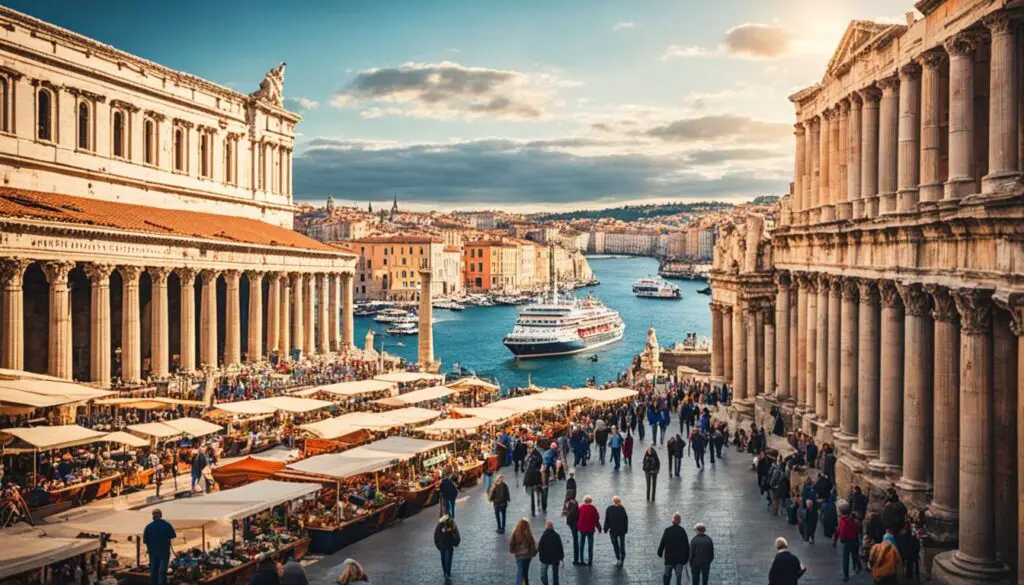
Ephesus, a vibrant city known for its grand Temple of Artemis, became a focal point of Paul’s ministry. He spent a considerable amount of time there, preaching and establishing a strong Christian community. Ephesus played a crucial role in the spread of Christianity throughout Asia Minor.
Miletus, a historic city located near Ephesus, also held significance for Paul. It was here that he delivered a heartfelt farewell address to the elders of the Ephesian church, emphasizing the importance of faith and dedication to the Gospel.
Corinth, a bustling port city, was another key stop on Paul’s journey. He spent a significant amount of time in Corinth, preaching and teaching, and later wrote two letters to the Corinthians that are now part of the New Testament. His impact on the Corinthians was profound, and the Christian community flourished under his guidance.
Paul’s journey also took him to Jerusalem, the spiritual center of Judaism. In Jerusalem, he faced challenges and opposition from religious leaders who were skeptical of his teachings. Despite the hardships, Paul’s unwavering dedication to spreading the Gospel remained steadfast.
This third missionary journey solidified Paul’s influential role in the early Christian movement. His teachings and presence left a lasting impact on the cities he visited, shaping the development of Christianity in the ancient world.
Other Cities Visited by Paul
In addition to the cities mentioned in Paul’s missionary journeys, he also visited other significant cities. These include Antioch in Syria, where he began his missionary endeavors, Troas, Tarsus (his hometown), Caesarea, and Rome. These cities played pivotal roles in Paul’s life and ministry, shaping the early Christian movement.
“I am on my way to Jerusalem in the service of the Lord’s people there. For Macedonia and Achaia were pleased to make a contribution for the poor among the Lord’s people in Jerusalem. They were pleased to do it, and indeed they owe it to them. For if the Gentiles have shared in the Jews’ spiritual blessings, they owe it to the Jews to share with them their material blessings.” – Romans 15:25-27
Antioch in Syria, located on the eastern bank of the Orontes River, served as a prominent center for early Christianity. It was in Antioch that the followers of Jesus were first called “Christians.” This diverse and cosmopolitan city provided a strategic starting point for Paul’s missionary endeavors.
Troas, situated in modern-day Turkey, was another city visited by Paul. It was here that he received a vision of a man from Macedonia calling for help, prompting him to journey to Europe for the spread of the Gospel.
Tarsus, Paul’s hometown, held personal significance for him. As a citizen of Tarsus, Paul enjoyed Roman citizenship, which granted him certain rights and privileges during his ministry.
Caesarea, a coastal city in modern-day Israel, was a crucial port city during Paul’s time. It was in Caesarea that Paul was held in custody for two years before being sent to Rome for trial.
Rome, the capital of the Roman Empire, was the pinnacle of Paul’s missionary journeys. As the epicenter of political and cultural influence, Rome provided Paul with a platform to spread the Gospel and engage with diverse communities.
Each of these cities holds a unique place in Paul’s narrative, showcasing the breadth and impact of his ministry. By visiting these cities, travelers can gain a deeper understanding of the early Christian movement and the lasting legacy of the Apostle Paul.
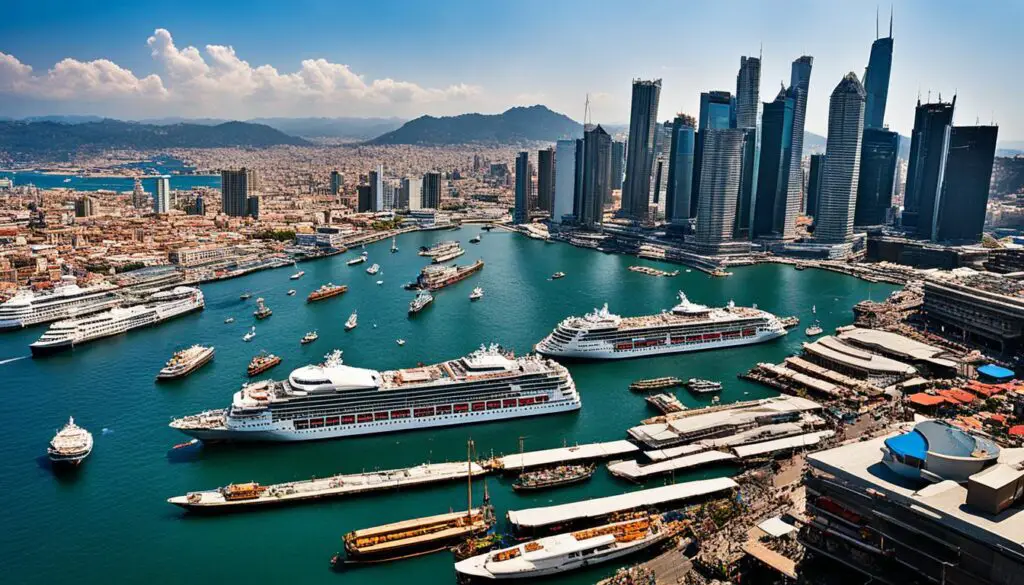
The Impact of Paul’s Ministry
Paul’s ministry had a profound impact on the spread of Christianity and the early Christian church. His travels and teachings laid the foundation for future generations of believers and played a crucial role in the formation and growth of Christian communities.

Through his letters, Paul provided guidance, encouragement, and theological insights that continue to influence Christians today. His writings, included in the New Testament, tackle various theological and practical issues faced by the early Christian church.
“For I am not ashamed of the gospel, because it is the power of God that brings salvation to everyone who believes…” – Romans 1:16
Paul’s evangelistic efforts and teachings contributed to the rapid spread of Christianity throughout the Mediterranean world. His missionary journeys established churches, nurtured new believers, and challenged existing religious practices.
The Spread of Christianity
The impact of Paul’s ministry extended far beyond his immediate reach. As he traveled from city to city, he shared the message of Jesus Christ, resulting in the conversion of countless individuals and the establishment of Christian communities.
Paul’s emphasis on the universality of the Gospel – that it was available to both Jews and Gentiles – allowed Christianity to transcend cultural boundaries and gain followers from diverse backgrounds.
- Paul’s ministry in Philippi:
- Established the first Christian community in Europe
- Epaphroditus became a key leader in the community
Paul’s teachings and leadership contributed to the early Christian church’s growth and influence, forging a path for future missionaries and establishing a solid theological framework.
Early Christian Church
The early Christian church faced numerous challenges and endured persecution, yet it continued to thrive and grow due to the impact of Paul’s ministry.
- The churches established by Paul became centers of worship and discipleship
- New believers were given spiritual guidance and mentoring
- Christian communities were formed, providing support and fellowship
As the spread of Christianity continued, the teachings and writings of Paul, along with the other apostles, provided a solid foundation for the emerging Christian faith.
| Impact of Paul’s Ministry | Examples |
|---|---|
| Spread of Christianity | Establishment of churches in various cities |
| Transformation of believers | Conversion of individuals from diverse backgrounds |
| Formation of Christian communities | Support, discipleship, and fellowship within local churches |
Exploring Paul’s Cities
Travelers interested in exploring Paul’s cities can immerse themselves in the rich historical sites and cultural tales associated with these locations. From walking the streets of Corinth and Ephesus to visiting the ancient ruins in Philippi and Athens, each city offers a unique glimpse into the world of the Apostle Paul and the early Christian movement.

The Historical Sites of Paul’s Cities
When visiting Corinth, be sure to explore the remarkable Acrocorinth, a fortress perched on a hilltop that offers breathtaking views of the surrounding area. In Ephesus, don’t miss the opportunity to marvel at the well-preserved Library of Celsus, a stunning example of ancient Roman architecture. The archaeological site in Philippi reveals remnants of the ancient city, including the Theater of Philippi and the Baptistery of St. Lydia. Lastly, a visit to Athens provides the chance to explore landmark sites like the Acropolis, where the Parthenon stands as a testament to the city’s rich history.
The Cultural Tales of Paul’s Cities
Each of Paul’s cities has its own unique cultural tales that add depth to the exploration. In Corinth, learn about the city’s association with Aphrodite and the prominent role of the Isthmian Games. Ephesus is renowned for its connection to the goddess Artemis and the Temple of Artemis, one of the Seven Wonders of the Ancient World. Philippi has a rich history of Roman influence and is known for its association with the Battle of Philippi, a turning point in Roman history. Athens, the birthplace of democracy and a hub of intellectual and philosophical thought, offers cultural tales of philosophers like Socrates, Plato, and Aristotle.
Exploring Paul’s cities allows travelers to delve into the fascinating historical sites and uncover the captivating cultural tales that make these destinations truly exceptional. Whether you’re a history enthusiast, a culture lover, or a spiritual seeker, these cities offer a remarkable journey through time and a deeper understanding of the Apostle Paul and his profound impact on the early Christian movement.
City Guides and Tours
In order to fully immerse yourself in the historical and cultural significance of Paul’s cities, many travel companies and organizations offer specialized city guides and tours. These curated experiences provide valuable insights, historical context, and expert commentary, allowing visitors to truly appreciate the significance of each location.
Whether you prefer exploring on foot or joining a guided tour, there are plenty of options available to suit your preferences. City guides offer detailed information about the attractions and landmarks in each city, providing a deeper understanding of the historical and religious importance of Paul’s missionary journeys.
These city tours often include visits to key sites such as ancient churches, archaeological sites, and other cultural landmarks. Knowledgeable guides offer fascinating narratives and contextualize the places you visit, allowing you to connect with the rich history and cultural heritage of Paul’s cities.
By joining a city tour or using a city guide, you can explore Paul’s cities with a well-informed perspective, gaining a deeper appreciation for the impact of his ministry. Whether you’re interested in the religious significance, historical importance, or the unique urban travel experience, these city guides and tours can provide a comprehensive and enriching experience.
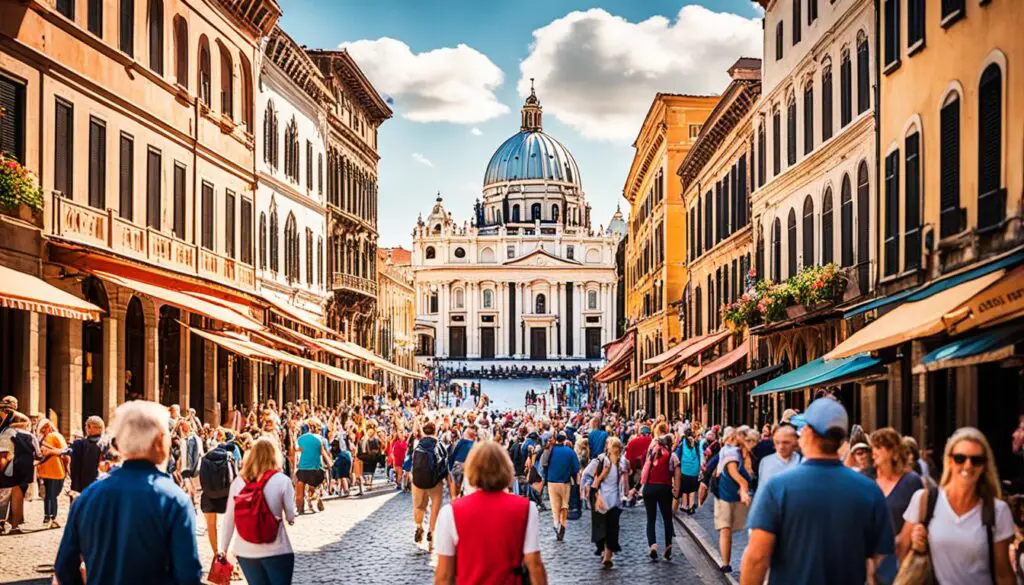
Conclusion
The cities visited by Paul during his missionary journeys hold immense historical and cultural significance. Exploring these cities provides a deeper understanding of the early Christian movement and the impact of Paul’s ministry. From Antioch to Rome, each city offers a unique glimpse into the transformative power of faith and the enduring legacy of the Apostle Paul.
Plan your journey to these cities and experience the rich tapestry of history and spirituality they offer. Whether you are interested in following the footsteps of Paul, exploring ancient ruins, or immersing yourself in the vibrant city life, Paul’s cities provide a diverse range of experiences for every traveler.
Discover the captivating stories behind these cities, walk the same streets as Paul did, and witness the historical landmarks that have shaped the Christian faith. By visiting Paul’s cities, you can further deepen your connection to the early days of Christianity and gain a renewed sense of inspiration and conviction in your own faith journey. Start planning your trip today to embark on an adventure that combines history, spirituality, and cultural exploration.
FAQ
What cities did Paul visit during his missionary journeys?
Paul visited numerous cities during his missionary journeys, including Antioch, Cyprus, Salamis, Paphos, Pisidian Antioch, Iconium, Lystra, Derbe, Philippi, Thessalonica, Athens, Corinth, Ephesus, Miletus, Jerusalem, Troas, Tarsus, Caesarea, and Rome.
What is the significance of Paul’s first missionary journey?
Paul’s first missionary journey laid the foundation for his future endeavors. It took him to Cyprus, Salamis, Paphos, Pisidian Antioch, Iconium, Lystra, and Derbe, where he faced both acceptance and opposition to the Gospel message.
Which cities did Paul visit on his second missionary journey?
On his second missionary journey, Paul revisited Lystra and Derbe, encountered Timothy, and traveled through Philippi, Thessalonica, Athens, and Corinth. These cities played crucial roles in the development of early Christian communities.
Which cities did Paul visit on his third missionary journey?
Paul’s third missionary journey took him to cities such as Ephesus, Miletus, Corinth, and Jerusalem. He spent a significant amount of time in Ephesus, establishing a strong Christian presence there.
Besides the cities mentioned in his missionary journeys, which other cities did Paul visit?
In addition to the cities visited during his missionary journeys, Paul also visited other significant cities such as Antioch in Syria, Troas, Tarsus, Caesarea, and Rome. These cities shaped Paul’s life and ministry.
What impact did Paul’s ministry have?
Paul’s ministry had a profound impact on the spread of Christianity and the early Christian church. His travels and teachings laid the foundation for future generations of believers and played a crucial role in the formation and growth of Christian communities.
How can I explore Paul’s cities?
Travelers interested in exploring Paul’s cities can immerse themselves in the rich historical sites and cultural tales associated with these locations. Walking the streets of Corinth and Ephesus, visiting ancient ruins in Philippi and Athens, and joining guided tours are great ways to delve into the history and spirituality of Paul’s missionary journeys.
Are there city guides and tours available for Paul’s cities?
Yes, many travel companies and organizations offer city guides and tours specifically focused on Paul’s cities. These guides provide valuable insights, historical context, and expert commentary, allowing visitors to fully appreciate the significance of each location.
What can I expect from city guides and tours of Paul’s cities?
City guides and tours of Paul’s cities offer informative experiences that take you through the footsteps of the Apostle Paul. You can expect to learn about the historical context, explore notable landmarks, and gain a deeper understanding of the impact Paul’s ministry had on the development of early Christian communities.
What is the significance of exploring Paul’s cities?
Exploring Paul’s cities provides a deeper understanding of the early Christian movement and the impact of Paul’s ministry. It offers a unique glimpse into the transformative power of faith and the enduring legacy of the Apostle Paul.
